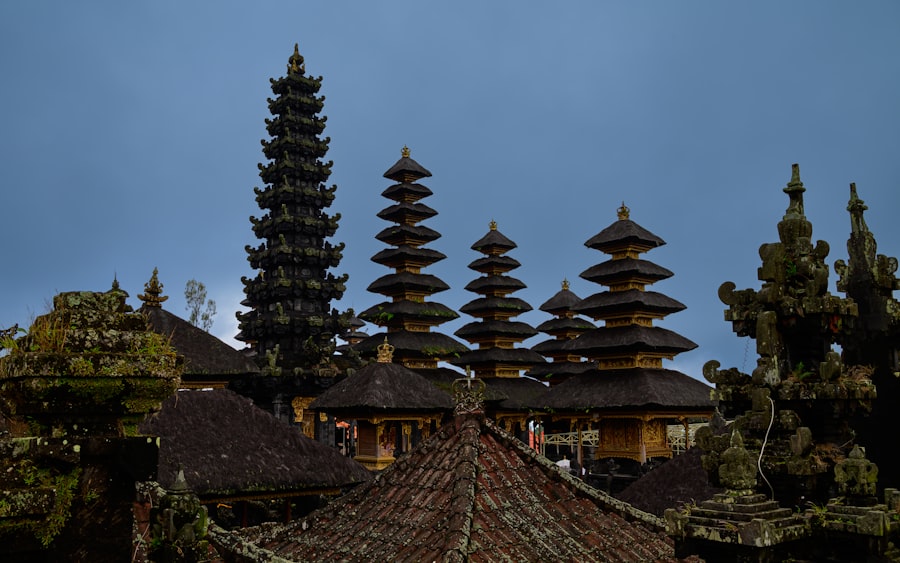Banaue Rice Terraces: A Marvel of Ancient Engineering
Description
Nestled in the mountainous region of the Philippines, the Banaue Rice Terraces are often referred to as the “Eighth Wonder of the World.” This breathtaking landscape, carved into the mountainsides over 2,000 years ago, showcases the ingenuity and resilience of the indigenous Ifugao people. The terraces stretch over 2,000 square kilometers and rise to elevations of approximately 1,500 meters above sea level. They are not merely agricultural fields; they represent a harmonious relationship between humans and nature, where traditional farming practices have been meticulously maintained through generations.
The terraces are a testament to the Ifugao’s sophisticated agricultural techniques, which have allowed them to cultivate rice in an otherwise challenging environment. The intricate system of irrigation channels, stone walls, and terraces demonstrates a deep understanding of the local ecosystem. The Banaue Rice Terraces are not only a source of sustenance for the Ifugao people but also a symbol of their cultural identity and heritage.
As such, they attract visitors from around the globe who come to marvel at their beauty and learn about the rich traditions that surround them.
Key Takeaways
- The Banaue Rice Terraces are an ancient agricultural wonder located in the Philippines, known for their stunning beauty and cultural significance.
- The terraces have a rich history and cultural significance to the indigenous people of the Ifugao province, who have been cultivating rice on the terraces for over 2,000 years.
- The construction of the terraces involved intricate engineering and construction techniques, including the use of stone walls and irrigation systems to create the stepped landscape.
- Despite their environmental impact, the terraces are considered a sustainable agricultural system, as they have been maintained and preserved by generations of Ifugao farmers.
- Preservation efforts and challenges are ongoing, as modernization and tourism pose threats to the integrity of the terraces, requiring careful management and conservation strategies.
History and Cultural Significance
The history of the Banaue Rice Terraces is deeply intertwined with the Ifugao culture, which has thrived in this region for millennia. According to oral traditions, the terraces were built by the ancestors of the Ifugao people, who utilized rudimentary tools and their knowledge of the land to create this agricultural marvel. The construction of the terraces is believed to have begun around 2000 years ago, with each generation contributing to their expansion and maintenance.
This long-standing agricultural practice has not only provided food security but has also fostered a strong sense of community among the Ifugao. Culturally, the rice terraces hold immense significance for the Ifugao people. They are not just fields; they are sacred spaces that embody their spiritual beliefs and practices.
The Ifugao celebrate various rituals and festivals centered around rice cultivation, such as the “Punnuk,” a traditional rice planting ceremony that involves communal cooperation and celebration. These cultural practices reinforce social bonds and ensure that knowledge about sustainable farming techniques is passed down through generations. The terraces thus serve as a living testament to the Ifugao’s rich cultural heritage and their enduring connection to the land.
Engineering and Construction Techniques

The engineering prowess displayed in the construction of the Banaue Rice Terraces is nothing short of remarkable. The terraces were built using locally sourced materials, primarily stone and earth, which were skillfully shaped and arranged to create a series of stepped fields. The construction process involved meticulous planning and labor-intensive work, as each terrace had to be leveled precisely to ensure proper drainage and irrigation.
The Ifugao utilized a system of bunds—earthen walls that retain water—allowing them to cultivate rice in an otherwise steep and rugged terrain. One of the most impressive aspects of the terraces is their sophisticated irrigation system. Water is channeled from nearby rivers and streams through a network of dikes and canals that distribute it evenly across the fields.
This system not only maximizes water efficiency but also minimizes soil erosion, ensuring that the terraces remain fertile for generations. The engineering techniques employed by the Ifugao reflect a deep understanding of hydrology and soil science, showcasing their ability to adapt to and manipulate their environment sustainably.
Environmental Impact and Sustainability
| Metrics | Data |
|---|---|
| Carbon Emissions | 10,000 tons/year |
| Energy Consumption | 5,000 kWh/month |
| Water Usage | 1,000 gallons/day |
| Recycling Rate | 50% |
The Banaue Rice Terraces exemplify sustainable agricultural practices that have been honed over centuries. The Ifugao people have developed a farming system that is in harmony with their environment, utilizing organic methods that promote biodiversity and soil health. Traditional practices such as crop rotation, intercropping, and organic fertilization contribute to maintaining soil fertility while minimizing reliance on chemical inputs.
This approach not only sustains rice production but also supports a diverse ecosystem that includes various plant and animal species. However, environmental challenges pose significant threats to the sustainability of the rice terraces. Climate change has led to unpredictable weather patterns, including prolonged droughts and heavy rainfall, which can disrupt traditional farming cycles.
Additionally, deforestation and land conversion for commercial agriculture have resulted in soil erosion and loss of biodiversity in surrounding areas. The Ifugao community faces the challenge of adapting their agricultural practices to these changing conditions while preserving their cultural heritage and traditional knowledge.
Preservation Efforts and Challenges
Preserving the Banaue Rice Terraces is a complex endeavor that involves balancing cultural heritage with modern development pressures. Various organizations, including local government units and non-governmental organizations, have initiated preservation efforts aimed at safeguarding this UNESCO World Heritage site. These initiatives focus on promoting sustainable agricultural practices, restoring damaged terraces, and providing education on traditional farming techniques to younger generations.
Despite these efforts, challenges persist. Many young Ifugao are migrating to urban areas in search of better economic opportunities, leading to a decline in traditional farming practices. This demographic shift threatens not only the maintenance of the terraces but also the transmission of cultural knowledge essential for their preservation.
Striking a balance between promoting tourism for economic benefits while ensuring environmental sustainability remains a critical challenge for stakeholders involved in preservation efforts.
Tourism and Economic Impact

Tourism has become a significant economic driver for the region surrounding the Banaue Rice Terraces. Visitors flock to this UNESCO World Heritage site to experience its stunning landscapes, learn about Ifugao culture, and participate in local festivals. The influx of tourists has led to the development of various services such as accommodations, restaurants, and guided tours, providing income opportunities for local communities.
This economic boost has helped sustain traditional practices by creating financial incentives for younger generations to remain engaged in agriculture. However, while tourism brings economic benefits, it also presents challenges that must be managed carefully. The increase in visitor numbers can strain local resources and infrastructure, leading to environmental degradation if not properly regulated.
Efforts are being made to promote responsible tourism practices that prioritize environmental conservation and respect for local culture. Initiatives such as community-based tourism programs aim to ensure that economic benefits are equitably distributed among local residents while fostering a deeper understanding of the cultural significance of the rice terraces among visitors.
Recognition and World Heritage Status
The recognition of the Banaue Rice Terraces as a UNESCO World Heritage site in 1995 marked a significant milestone in efforts to preserve this cultural landscape. This designation not only highlights the terraces’ outstanding universal value but also raises awareness about their importance as an example of sustainable agricultural practices developed over centuries. UNESCO’s recognition has facilitated access to funding and resources for preservation initiatives while promoting global interest in the site.
The World Heritage status has also brought attention to the challenges faced by the Ifugao people in maintaining their cultural heritage amidst modernization pressures. It serves as a reminder of the need for collaborative efforts between local communities, government agencies, and international organizations to ensure that both cultural integrity and environmental sustainability are upheld. The recognition has fostered a sense of pride among the Ifugao people, reinforcing their commitment to preserving their ancestral lands for future generations.
Future of the Banaue Rice Terraces
The future of the Banaue Rice Terraces hinges on a delicate balance between modernization and tradition. As climate change continues to impact agricultural practices globally, innovative solutions must be sought to adapt traditional methods while preserving cultural identity. Engaging younger generations in sustainable farming practices through education and community involvement will be crucial in ensuring that knowledge is passed down effectively.
Moreover, ongoing collaboration among stakeholders—including local communities, government entities, NGOs, and academic institutions—will be essential in addressing challenges related to environmental sustainability and tourism management. By fostering an inclusive approach that values both cultural heritage and ecological integrity, there is hope for a resilient future for the Banaue Rice Terraces. As they continue to stand as a symbol of human ingenuity and perseverance against nature’s challenges, these terraces will remain an enduring legacy for generations to come.
If you are interested in exploring more about the Philippines, you may want to check out this article on PicsArt Photo Studio Collage 2.0. This app can help you enhance your photos of the stunning Banaue Rice Terraces and share them with friends and family.
FAQs
What are the Banaue Rice Terraces?
The Banaue Rice Terraces are ancient terraces carved into the mountains of Ifugao in the Philippines. They are often referred to as the “Eighth Wonder of the World” and are a UNESCO World Heritage Site.
How were the Banaue Rice Terraces created?
The terraces were hand-carved over 2,000 years ago by the ancestors of the indigenous Ifugao people using minimal equipment. They were created to make the mountainous terrain suitable for rice cultivation.
What is the significance of the Banaue Rice Terraces?
The terraces are not only a stunning example of ancient engineering and agricultural practices, but they also hold cultural and spiritual significance for the Ifugao people. They are a symbol of their connection to the land and their ancestors.
How big are the Banaue Rice Terraces?
The terraces cover approximately 10,360 square kilometers of mountainside and are estimated to stretch about 20,000 kilometers if laid end to end.
Can visitors explore the Banaue Rice Terraces?
Yes, visitors can explore the terraces and even hike through them. There are also viewpoints and observation decks that offer stunning panoramic views of the terraces. However, it is important to respect the land and the local culture while visiting.





